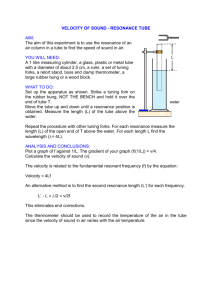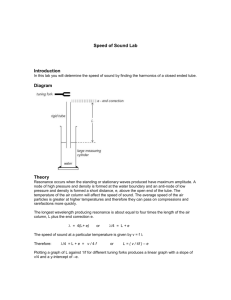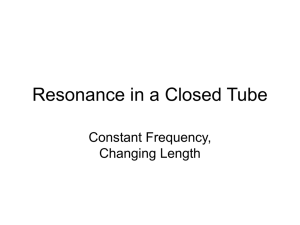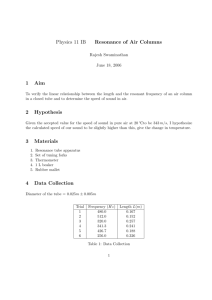LAB17PHYSICS.doc
advertisement
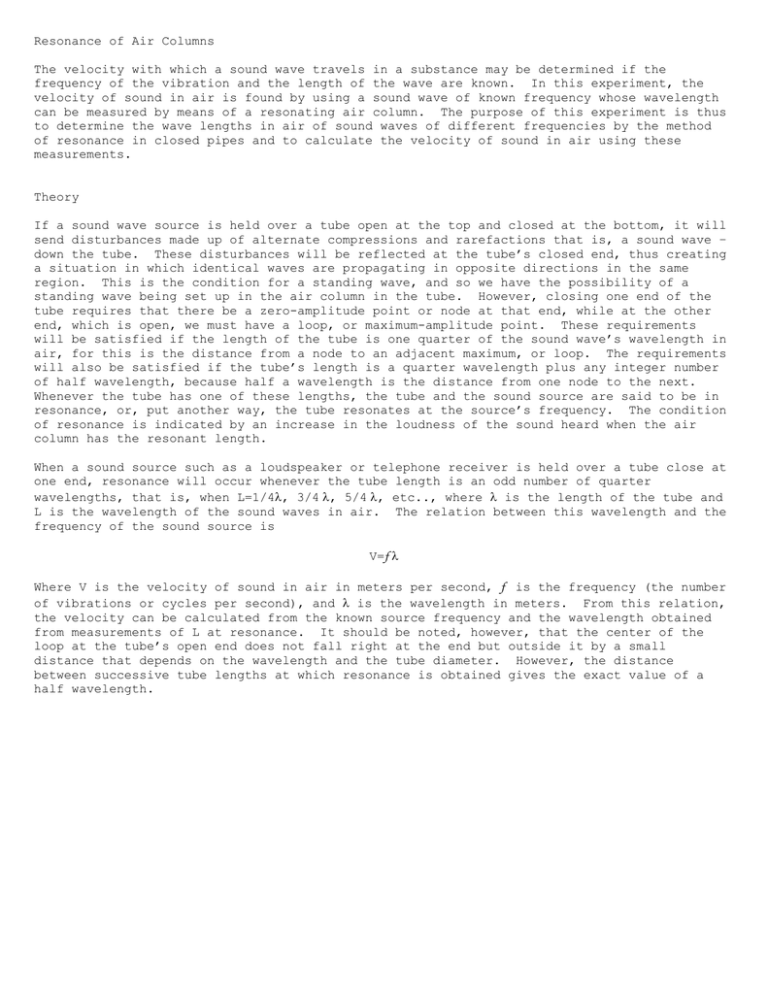
Resonance of Air Columns The velocity with which a sound wave travels in a substance may be determined if the frequency of the vibration and the length of the wave are known. In this experiment, the velocity of sound in air is found by using a sound wave of known frequency whose wavelength can be measured by means of a resonating air column. The purpose of this experiment is thus to determine the wave lengths in air of sound waves of different frequencies by the method of resonance in closed pipes and to calculate the velocity of sound in air using these measurements. Theory If a sound wave source is held over a tube open at the top and closed at the bottom, it will send disturbances made up of alternate compressions and rarefactions that is, a sound wave – down the tube. These disturbances will be reflected at the tube’s closed end, thus creating a situation in which identical waves are propagating in opposite directions in the same region. This is the condition for a standing wave, and so we have the possibility of a standing wave being set up in the air column in the tube. However, closing one end of the tube requires that there be a zero-amplitude point or node at that end, while at the other end, which is open, we must have a loop, or maximum-amplitude point. These requirements will be satisfied if the length of the tube is one quarter of the sound wave’s wavelength in air, for this is the distance from a node to an adjacent maximum, or loop. The requirements will also be satisfied if the tube’s length is a quarter wavelength plus any integer number of half wavelength, because half a wavelength is the distance from one node to the next. Whenever the tube has one of these lengths, the tube and the sound source are said to be in resonance, or, put another way, the tube resonates at the source’s frequency. The condition of resonance is indicated by an increase in the loudness of the sound heard when the air column has the resonant length. When a sound source such as a loudspeaker or telephone receiver is held over a tube close at one end, resonance will occur whenever the tube length is an odd number of quarter wavelengths, that is, when L=1/4, 3/4, 5/4, etc.., where is the length of the tube and L is the wavelength of the sound waves in air. The relation between this wavelength and the frequency of the sound source is V=f Where V is the velocity of sound in air in meters per second, f is the frequency (the number of vibrations or cycles per second), and is the wavelength in meters. From this relation, the velocity can be calculated from the known source frequency and the wavelength obtained from measurements of L at resonance. It should be noted, however, that the center of the loop at the tube’s open end does not fall right at the end but outside it by a small distance that depends on the wavelength and the tube diameter. However, the distance between successive tube lengths at which resonance is obtained gives the exact value of a half wavelength. In this experiment, a closed pipe of variable length is obtained by changing the level of the water contained in a glass tube. The length of the tube above the water level is the length of the air column in use. The apparatus is shown in Fig. 17.1 consists of a glass tube 1.2 m long closed at the bottom with a cup and mounted on a heavy tripod base. A supply tank, which is connected to the cup by a rubber hose, is attached to the support rod by means of a clamp, which permits easy adjustment. The sound source used in this experiment consists of a small loudspeaker driven by a signal generator, and a clamp on the support rod holds this loudspeaker directly above the tube. If the sound level is to be detected by a microphone, it too, is held just above the tube and next to the loudspeaker by means of a second clamp. The velocity of sound in air is 331.4m/s at 0 degrees Celsius. velocity is slightly greater than this, and is given by V = 331.4 + 0.6t At higher temperatures, the (17.2) Where V is the velocity in meters per second and t is the temperature in degrees Celsius. Equation 17.2 can be used to get a more accurate value for the speed of sound at the laboratory room temperature. APPARATUS 1. 2. 3. 4. 5. 6. 7. 8. Resonance tube apparatus Signal generator Loudspeaker or telephone receiver Meter stick Clamp to mount loudspeaker Celsius thermometer Microphone and mounting clamp (optional) Sound level indicator (optional) PROCEDURE 1. 2. 3. 4. Using the clamp provided, mount the loudspeaker or telephone receiver so that it faces into the open end of the long glass tube and is about 2cm above it. If a microphone is to be used to detect the sound level, it too, should be mounted facing the top of the tube. In this case, the loudspeaker may be mount ed a little to one side and slanted to face toward the tube end, thus making room for the microphone beside it. Fill the supply tank with water and raise it to adjust the water level in the long tube to a point near the top. Do not overfill the supply tank or it will overflow when you lower it. Turn on the signal generator and set it to a frequency of 500 cycles or Hz. Connect the loudspeaker or telephone receiver to the generator output and adjust the level to give it a low but audible volume of the 500-Hz tone. Determine the shortest tube length for which resonance is heard by slowly lowering the water level while listening for resonance to occur. At resonance, that is when the air column is adjusted to the proper length there will be a sudden increase in the intensity of the sound that you can detect either by listening, or if you have the equipment, by noting the rise in the reading of the sound level indicator connected to the microphone. When the approximate length for resonance has been found, run the water level up and down near this point to determine the position for which the sound level is maximum. Measure and record the length of the resonating air column to the nearest millimeter. Make two additional determinations of this length by changing the water level and relocating the position of the maximum. Record these two readings also. 5. 6. 7. Lower the water level until the second position at which resonance occurs is found and repeat Procedure 4 to determine the air-column length for this case. As in Procedure, make three independent determinations of this length and record each to the nearest millimeter. Do not change either the frequency or the sound level from the settings used in Procedure 4. Repeat Procedures 3-5 with signal generator frequencies of 400 and 300 Hz. Record your three frequencies in the spaces provided in the data table. Record the room temperature of your laboratory. DATA Known value of the velocity of sound at room temperature Room temperature Calculated value of the velocity of sound in air average Table 1 SOURCE FREQUENCY Percent error FIRST POSITON OF RESONANCE SECOND POSITION OF RESONANCE 1 1 2 3 AVERAGE 2 3 WAVELENGTH AVERAGE VELOCITY OF SOUND IN AIR FIRST POSITION VELOCITY OF SOUND IN AIR SECOND POSITION CALCULATIONS 1. 2. 3. 4. For each length of resonating air column, calculate the average of the three readings taken. For each frequency, determine the value of the wavelength in air from the lengths of the resonating air column. For each frequency, calculate the velocity of sound in air from the wavelength found in Calculation2. Find the average of these three values. Calculate the velocity of sound in air at room temperature from Equation 17.2 V = 331.4 + 0.6t 5. (17.2) Compare the average value of the velocity of sound as found in Calculation 3 with the known values as found in Calculation 4 by finding the percent error. QUESTIONS 1. 2. 3. 4. 5. 6. Suppose that in this experiment the temperature of the room had been lower. What effect would this have had on the length of the resonating air column for each reading? Explain. How would an atmosphere of hydrogen affect the pitch of an organ pipe? A 128-Hz sound source is held over a resonance tube. What are the two shortest distances at which resonance will occur at a temperature of 20 degrees Celsius? A sound source is held over a resonance tube, and resonance occurs when the surface of the water in the tube is 10cm below the source. Resonance occurs again when the water is 26cm below the source. If the temperature of the air is 20 degrees Celsius, calculate the source frequencies. An observer measured an interval of 10s between seeing a lightning flash and hearing the thunder. If the temperature of the air was 20 degrees Celsius, how far away was the source of sound? From the spread in your data for this experiment, estimate limits of error to be attached to your measured value of the velocity of sound in air. Does the accepted value fall within these limits? If it does not, can you offer an explanation for the discrepancy?
